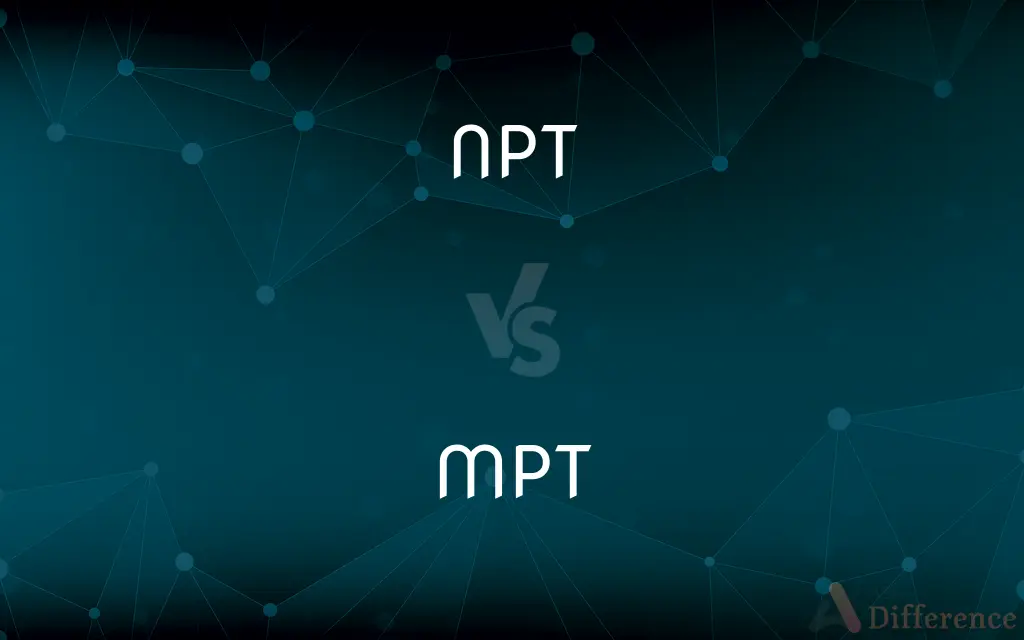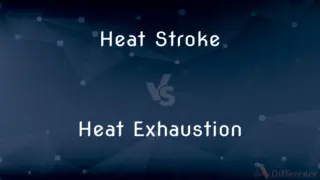NPT vs. MPT — What's the Difference?
By Maham Liaqat & Fiza Rafique — Published on March 3, 2024
NPT (National Pipe Thread) and MPT (Male Pipe Thread) refer to the threading on pipes and fittings. NPT is a standard for tapered threads used to ensure a tight seal, while MPT specifically describes male tapered threads that conform to the NPT standard.

Difference Between NPT and MPT
Table of Contents
ADVERTISEMENT
Key Differences
NPT is a U.S. standard for tapered threads used on threaded pipes and fittings. It ensures a fluid-tight seal through the use of tapered threads, where the diameter of the thread increases or decreases along the length of the thread. This design allows for a tighter and more secure fit as the threads are engaged, making it ideal for applications involving the transfer of liquids or gases.
MPT, or Male Pipe Thread, refers to the external threads of a pipe or fitting that screw into a female counterpart (FPT, Female Pipe Thread). MPT is essentially a subset of NPT, adhering to the same standards and dimensions for taper and thread count. The designation of MPT highlights the gender of the threading, indicating it is meant to be inserted into a corresponding FPT fitting.
Both NPT and MPT threads are designed to create a seal without the need for additional sealing mechanisms. However, in practice, Teflon tape or pipe dope is often used on the threads to ensure a completely leak-proof connection, especially in applications involving water, gas, or oil.
The difference between NPT and MPT primarily lies in the context of their usage rather than their physical characteristics. NPT refers broadly to the standard covering both male and female threads, while MPT specifically identifies the male threaded end. When specifying pipe connections, it's common to see NPT used to describe the general thread type and MPT or FPT used to specify the gender of the threads.
Understanding the distinction between NPT and MPT is crucial for ensuring compatibility and a proper seal in piping systems. Incorrectly matching the threads can result in leaks or damage to the threads, compromising the integrity of the connection.
ADVERTISEMENT
Comparison Chart
Definition
A standard for tapered threads on pipes and fittings to ensure a tight seal.
Specifies the male (external) threads of a pipe or fitting that conform to the NPT standard.
Application
Used in a wide range of applications involving the transfer of fluid and gas.
Used to describe the male part of the connection that screws into an FPT (Female Pipe Thread) counterpart.
Thread Type
Tapered, to create a seal by the threads themselves.
Tapered, following the NPT standard for male threads.
Gender
Refers to both male and female threading within the standard.
Specifically refers to male (external) threading.
Usage
Broad term for the threading standard on both male and female fittings.
Used to specify the gender of NPT threads when necessary for clarity.
Compare with Definitions
NPT
Suitable for various applications, including water, gas, and oil.
Industrial piping systems often rely on NPT standards for safe fluid transfer.
MPT
MPT fittings are designed to fit into corresponding FPT fittings.
Secure the MPT end of the pipe into the FPT fitting for a tight connection.
NPT
Sealing compound or tape is typically used with NPT threads for a perfect seal.
Apply Teflon tape to NPT threads to prevent leaks in water pipes.
MPT
The use of sealing agents is recommended for MPT connections.
Before connecting, wrap MPT threads with Teflon tape to enhance the seal.
NPT
NPT is a standard for tapered pipe threads designed to ensure a fluid-tight seal.
Most plumbing systems in North America use NPT fittings for leak-proof connections.
MPT
Common in applications requiring a secure and leak-proof connection.
MPT connections are essential in maintaining pressure in hydraulic systems.
NPT
NPT threads taper to create a tighter seal as they are engaged.
When assembling a gas line, NPT threads are tightened to form a gas-tight seal.
MPT
MPT describes the external threads on pipes and fittings that screw into FPT connections.
The garden hose nozzle features MPT threads to attach to the hose.
NPT
It applies to both male and female thread designs for compatibility.
NPT connections require both MPT and FPT components to complete the seal.
MPT
It adheres to the NPT standard but specifies the male threading.
When ordering parts, specify MPT size to ensure compatibility with female threads.
Common Curiosities
Are NPT and MPT interchangeable with other threading standards?
NPT and MPT are not directly interchangeable with other threading standards without adapters due to their unique taper and thread design.
Can MPT be connected to any type of thread?
MPT is designed to connect with FPT (Female Pipe Thread) that also follows the NPT standard, ensuring a tight and secure fit.
How do I know if a fitting is NPT or MPT?
If a fitting is described as NPT and appears to have external threads, it can be considered MPT by default. Fittings with internal threads conforming to the NPT standard are known as FPT.
Can I use NPT fittings with metric threads?
NPT and metric threads have different standards and dimensions, making them incompatible without the use of an adapter designed to bridge the two systems.
What does the number following NPT or MPT indicate?
The number following NPT or MPT usually refers to the nominal pipe size in inches, indicating the diameter of the threads, which helps in identifying the size of the fitting required for a particular application.
What is the main difference between NPT and MPT?
The main difference is that NPT refers to the standard for tapered threads on both male and female fittings, while MPT specifically describes the male external threads that conform to the NPT standard.
Do I need to use Teflon tape with NPT and MPT connections?
While NPT and MPT threads are designed to form a seal on their own, Teflon tape or pipe dope is often used to ensure a completely leak-proof connection.
Is it possible to overtighten NPT or MPT connections?
Yes, overtightening NPT or MPT connections can damage the threads or the fittings themselves, leading to leaks or failure of the connection. It's important to follow proper torque specifications.
How do I choose between NPT and MPT fittings for my project?
Choose MPT fittings when you need a male external threaded connection and ensure the counterpart is FPT. The choice largely depends on the specific requirements of your connection, including gender compatibility and the need for a tapered thread for sealing.
Can NPT and MPT fittings be used for both liquid and gas applications?
Yes, NPT and MPT fittings are designed to create a tight seal, making them suitable for transferring both liquids and gases, provided the materials are compatible with the substances being handled.
How do I measure NPT or MPT threads?
To measure NPT or MPT threads, use a thread gauge to determine the threads per inch and a caliper to measure the outer diameter of male threads (MPT) or the inner diameter of female threads (FPT).
What's the difference between NPTF and NPT?
NPTF (National Pipe Taper Fuel) threads are designed to provide a tighter seal than standard NPT threads, often eliminating the need for additional sealing methods. NPTF is sometimes referred to as "dry-seal thread."
Are NPT connections reusable?
NPT connections can be reusable, but care must be taken to avoid damaging the threads. Reapplying a sealing compound or tape is recommended to ensure a leak-proof seal upon reconnection.
Do I need special tools to install NPT or MPT fittings?
While no special tools are required for installing NPT or MPT fittings, using a proper pipe wrench or adjustable wrench is recommended for tightening, along with thread tape or pipe dope for sealing.
Can NPT or MPT fittings be used in high-pressure applications?
NPT and MPT fittings can be used in high-pressure applications, but it's important to select fittings rated for the specific pressure requirements and to use appropriate sealing methods to prevent leaks.
Share Your Discovery

Previous Comparison
Heat Stroke vs. Heat Exhaustion
Next Comparison
Chancellor vs. Vice ChancellorAuthor Spotlight
Written by
Maham LiaqatCo-written by
Fiza RafiqueFiza Rafique is a skilled content writer at AskDifference.com, where she meticulously refines and enhances written pieces. Drawing from her vast editorial expertise, Fiza ensures clarity, accuracy, and precision in every article. Passionate about language, she continually seeks to elevate the quality of content for readers worldwide.
















































